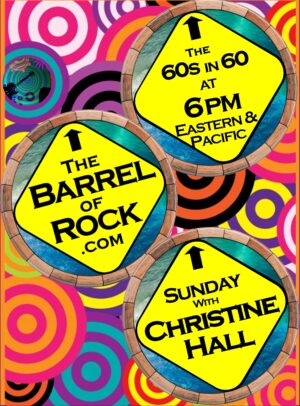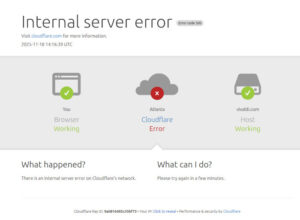Much like Linux had trouble gaining users back in the day because the general public didn’t know about it, independent online radio stations like The Barrel of Rock are having trouble finding an audience because potential listeners can’t wade through tens of thousands of music radio stations to find them.

Online radio stations that aren’t established or backed by megabucks are having a problem with the marketplace that should be very familiar to dyed-in-the-wool Linux users.
Remember the days when one of the reasons we couldn’t get “the year of the Linux desktop” happening was because none of the big computer makers would offer their desktops and laptops with Linux preinstalled? This meant that the average computer user remained ignorant, since computer showrooms only displayed machines with Windows or macOS installed, so they weren’t being told about Linux or given the opportunity to kick the tires on a machine running one of the easy-to-use Linux distributions of the day.
In fact, if the average user knew anything at all about Linux, it was that it was “difficult to use,” which was what folks like Microsoft were telling anyone who would listen.
Although that situation has changed a lot for those of us who already use Linux, it still hasn’t changed in a way that’s meaningful for those who’ve never used anything other than Windows or Mac. Sure, you can easily order machines from outfits that specialize in Linux-based computers, such as System76, Tuxedo, and Purism, but they’re targeted at those who already know and use Linux. And while it’s true that most mainline computer makers, such as Dell and HP, offer several lines of computers with Linux preinstalled, you pretty much have to know what you’re looking for to find them.
Even more importantly, you’re absolutely not going to walk into Best Buy or any other consumer-focused electronics store and find any computers with Linux preinstalled, meaning you’re still not going to learn that there’s an easy-to-use Windows alternative.
Operators of independent online radio stations say that they are finding themselves in a similar situation in their quest to attract listeners, because potential listeners can’t find them. This is a problem because radio stations have to have listeners to survive, but even with the best programing possible, they’re not going to be able to attract listeners if potential listeners can’t find them for that first listen.
What this means is that although online listenership continues to be on the rise, online radio is dominated by what I’ll call the usual suspects. Wanna venture a guess as to what online music radio station has by far the most listeners? If you guessed iHeart Radio, the same folks who dominate over-the-air radio these days, you can move to the head of the class — you’re correct.
Finding a Needle in a Haystack
The problem faced by operators of independent online radio stations is similar but different to desktop Linux’s struggle to gain users.
It’s different, because the main problem faced by stations seeking listeners is that there are too many radio stations on the online radio dial — way too many for listeners to find you if they don’t already know you’re there. How many online stations are there? According to Radio.co, there are more than 70,000 online radio stations, with the majority broadcasting some sort of music format.
I single out the music stations because finding listeners isn’t as much a problem for online talkers, since most have content tailored for niche audiences (a MAGA-focused talker will probably be able to attract listeners through social media and word-of-mouth, for example). Nor is it much of an issue for broadcasters that are well established in over-the-air radio, which explains the dominance of iHeart Radio, which has 855 terrestial stations that are said to reach more than 110 million listeners each weeks, or second place National Public Radio, which can drive listeners to its online programming through links on the websites of its affiliate stations.

To be sure, online radio has plenty of listeners to offer. According to Edison Research, in 2015 53% of US residents age 12+ were monthly listeners of online radio, meaning online broadcasters were reaching at least 143 million people per month. That was eight years ago, and that number has continued to rise. In April 2022, Statista reported, “Over two-thirds of Americans report that they listen to online radio on a monthly basis, while 62% consider themselves at least weekly users.” That puts the monthly audience in the US at about 222 million and the weekly audience at somewhere around 206 million — more than enough to go around, in other words.
That’s little comfort for independent online broadcasters with limited budgets however, since those listeners will likely never find them. Even online services that promise to make it easier for listeners to find just the right station are of little help. For example, Radio.net, which offers a mobile app for listening to online radio, offers its users a choice of 5,751 stations in the rock radio category alone.
Example: The Barrel of Rock
One of the stations facing this problem is my favorite online station, The Barrel of Rock (full disclosure: I host a two hour show of ’60s music there every Sunday), a station that was started a couple of years ago by Matthew Arnett, who cut his teeth as a disc jockey at KLRB on California’s Monterey Peninsula. That station was one of the last of the old-school free-form album-oriented-rock stations where the jocks picked the music they played instead of following a playlist proscribed by some consultant from out-of-town.
After that station went off the air in 1983 (Arnett was the last person to say the KLRB call letters on the air), he remained in radio, working at some legendary rock outlets in the area, including KMBY in the Monterey-area and KOME in San Jose (the latter used to famously say during station breaks, “You have KOME on your dial.”) Over the decades that followed, he built a reputation with his Matthew in the Morning show, which he carried from station to station, mostly in California, but which included a stint in the early part of this century on Atlantic City’s WZXL. Not only was his show a ratings winner everywhere he went, it also garnered a stack of awards, like the Radio & Records Show/Personality of the Year Industry Achievement Award that he picked up in Atlantic City.

He’s also a friend of mine. I met Matthew in the late seventies when he was at KLRB and I was doing the morning drive shift for a sports-focused station on the other side of town. For a couple of weeks, we even worked together at the same station, KRML, the station where Clint Eastwood’s “Play Misty for Me” was filmed, and where Arnet was doing basketball play-by-play for a local high school.
I point to his resume to make it clear that when he decided to start his own online rock radio station, he wasn’t just a guy who thought people would love his record collection, he was a professional coming to the table with decades of experience in rock radio, having worked at more than a few legendary rock radio stations.
The station sounds great, and it’s pretty much where I’ve been going for the last couple of years whenever I’ve wanted to listen to music on the radio. It’s commercial-free, and he plans to keep it that way, and listener supported in a way that doesn’t require boring fundraising drives. He’s also recruited on-air talent with resumes that include time spent at some of the most legendary rock stations in Central and Northern California.
It’s also fun, with lots of unusual features, like “listener takeover Fridays,” which offers listeners the chance to be a DJ for an hour just for the asking.
You don’t have to take my word for it. At the top of this and every other article on FOSS Force we’ve embedded the station’s player, so you can click play, then listen and make up your own mind. Although I guess that the player is officially an advertisement, we’re not getting any money for it — it’s just our way of trying to help. In fact, neither Arnett nor his team even knows it’s there (although I’m sure they’ll soon find out).
The station has listeners and they’re loyal, with a large percentage paying for membership, which gives them a few perks such as access to a special “backstage” webpage, the ability to request songs whenever they want, and stuff like that, but it needs more listeners if it’s to be sustainable over the long haul.
I have no doubt that if this was an over-the-air station, where it could be easily found with a quick scan of the FM radio dial, it would’ve had more than enough listeners soon after it went on the air.
As it is, it’s a lot like desktop Linux trying to gain users in a world where all people know about are Windows and Macs.
Christine Hall has been a journalist since 1971. In 2001, she began writing a weekly consumer computer column and started covering Linux and FOSS in 2002 after making the switch to GNU/Linux. Follow her on Twitter: @BrideOfLinux








This Barrel of Rock seems to be classic rock, which bores me. I prefer top 40 from the 1980’s and 1990’s. Are there any online indy stations you’d recommend for me?
Hi Steve! The best place to start your search would probably be Live365. That’s the streaming service used by most independent online broadcasters because they take care of paying the required royalties to the artists, record companies, and songwriters, which is a huge undertaking for small operations. Beware though that they stream for thousands of stations, but the good news is that they’ll let you define your search by category. Here’s the URL: https://live365.com/listen
Unfortunately for me “This station is unavailable for streaming in your country” 🙁
But hey, thanks for the link to Live365! I’ll make sure to check it out.
Same here in Oz,
Sorry, streaming is unavailable in your country.
Good story though I was ready to tune in, what a shame, another case of meh Aussies luck out ‘again’